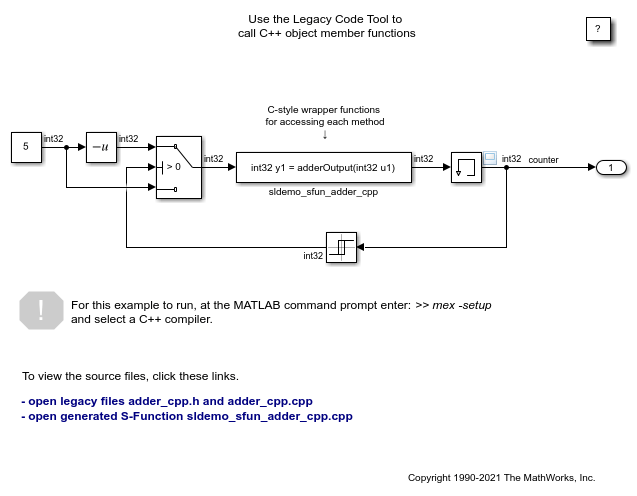C++ Object Methods as Legacy Functions
This example shows you how to use the Legacy Code Tool to integrate legacy C++ object methods.
The Legacy Code Tool allows you to:
Provide the legacy function specification,
generate a C++ MEX S-function that is used during simulation to call the legacy code, and
Compile and build the generated S-function for simulation.
Providing the Legacy Function Specification
Functions provided with the Legacy Code Tool take a specific data structure or array of structures as the argument. The data structure is initialized by calling the function legacy_code() using 'initialize' as the first input. After initializing the structure, you have to assign its properties to values corresponding to the legacy code being integrated. The definition of the legacy C++ class being used in this example is:
class adder {
private:
int int_state;
public:
adder();
int add_one(int increment);
int get_val();
};The legacy source code is found in the files adder_cpp.h and adder_cpp.cpp.
% sldemo_sfun_adder_cpp def = legacy_code('initialize'); def.SFunctionName = 'sldemo_sfun_adder_cpp'; def.StartFcnSpec = 'createAdder()'; def.OutputFcnSpec = 'int32 y1 = adderOutput(int32 u1)'; def.TerminateFcnSpec = 'deleteAdder()'; def.HeaderFiles = {'adder_cpp.h'}; def.SourceFiles = {'adder_cpp.cpp'}; def.IncPaths = {'sldemo_lct_src'}; def.SrcPaths = {'sldemo_lct_src'}; def.Options.language = 'C++'; def.Options.useTlcWithAccel = false;
Generating and Compiling an S-Function for Use During Simulation
The function legacy_code() is called again with the first input set to 'generate_for_sim' in order to automatically generate and compile the C-MEX S-function according to the description provided by the input argument 'def'. This S-function is used to call the legacy functions in simulation. The source code for the S-function is found in the file sldemo_sfun_adder_cpp.cpp.
legacy_code('generate_for_sim', def);
### Start Compiling sldemo_sfun_adder_cpp
mex('-I/tmp/Bdoc25b_2988451_749057/tpdd3cc555/simulink_features-ex93865240/sldemo_lct_src', '-I/tmp/Bdoc25b_2988451_749057/tpdd3cc555/simulink_features-ex93865240', '-c', '-outdir', '/tmp/Bdoc25b_2988451_749057/tpca4278b8_ca90_42bb_8b19_b828c0c20d7d', '/tmp/Bdoc25b_2988451_749057/tpdd3cc555/simulink_features-ex93865240/sldemo_lct_src/adder_cpp.cpp')
Building with 'g++'.
MEX completed successfully.
mex('sldemo_sfun_adder_cpp.cpp', '-I/tmp/Bdoc25b_2988451_749057/tpdd3cc555/simulink_features-ex93865240/sldemo_lct_src', '-I/tmp/Bdoc25b_2988451_749057/tpdd3cc555/simulink_features-ex93865240', '-cxx', '/tmp/Bdoc25b_2988451_749057/tpca4278b8_ca90_42bb_8b19_b828c0c20d7d/adder_cpp.o')
Building with 'g++'.
MEX completed successfully.
### Finish Compiling sldemo_sfun_adder_cpp
### Exit
Generating an rtwmakecfg.m File for Code Generation
After the TLC block file is created, the function legacy_code() can be called again with the first input set to 'rtwmakecfg_generate' in order to generate an rtwmakecfg.m file to support code generation through Simulink® Coder™. Generate the rtwmakecfg.m file if the required source and header files for the S-functions are not in the same directory as the S-functions, and you want to add these dependencies in the makefile produced during code generation.
Note: Complete this step only if you are going to simulate the model in accelerated mode.
legacy_code('rtwmakecfg_generate', def);
Generating a Masked S-Function Block for Calling the Generated S-Function
After the C-MEX S-function source is compiled, the function legacy_code() can be called again with the first input set to 'slblock_generate' in order to generate a masked S-function block that is configured to call that S-function. The block is placed in a new model and can be copied to an existing model.
% legacy_code('slblock_generate', def);
Integration with Legacy Code
The model sldemo_lct_cpp sldemo_lct_cpp shows integration with the legacy code.
open_system('sldemo_lct_cpp') sim('sldemo_lct_cpp');
